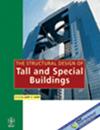In‐plane stability and shear deformation analysis of the H‐beam hollow arch
IF 1.3
3区 工程技术
Q3 CONSTRUCTION & BUILDING TECHNOLOGY
引用次数: 0
Abstract
H‐shaped circular arc is a relatively novel type of open‐web steel arch, and currently, no reports have been published concerning its in‐plane stability. In this paper, the elastic and elastic–plastic in‐plane stability of the H‐shaped hollow circular arch is studied by theoretical deduction combined with numerical simulation. First, the overall shear rigidity of the H‐shaped circular arch is calculated, and the elastic buckling load formula of the arch is proposed and verified considering double shear deformation under full‐span radial and uniform loading. The overall elastic buckling load deduced in this paper is reasonable according to the finite element analysis. The results indicate that the influence of shear deformation on the overall elastic buckling load of the arch decreases with the increase of the span length. The arch‐bearing capacity is the largest when the rise‐span ratio is 0.25. Second, the restriction conditions necessary for avoiding local buckling of the chordal web before integral buckling of the H‐shaped steel hollow circular arch are analyzed. Finally, the elastic–plastic failure mechanism of the H‐shaped arch under full‐span radial and uniform loading is examined, and the formula for determining the ultimate bearing capacity that is achievable before failure under full‐span radial and uniform loading is proposed. ANSYS analysis shows that under the radial uniform loading, the chordal bars will yield near 1/4L and 3/4L, and ultimately, the structural failure of the lower chord occurs in the vicinity of 1/4L. The formulas presented in this paper agree well with the results obtained from the finite element analysis and can be used as a reference for engineering applications.H型钢空心拱的面内稳定性及剪切变形分析
H形圆弧是一种相对新颖的开腹钢拱,目前尚未发表关于其平面内稳定性的报道。本文采用理论推导和数值模拟相结合的方法,对H型空心圆拱的弹塑性平面内稳定性进行了研究。首先,计算了H形圆拱的整体抗剪刚度,提出并验证了考虑全跨径向均匀荷载作用下双剪变形的H形圆拱形的弹性屈曲荷载公式。通过有限元分析,本文推导的整体弹性屈曲载荷是合理的。结果表明,剪切变形对拱整体弹性屈曲荷载的影响随着跨度的增加而减小。当升跨比为0.25时,拱的承载力最大。其次,分析了H型钢空心圆拱整体屈曲前避免弦腹板局部屈曲所需的约束条件。最后,研究了H型拱在全跨度径向和均匀荷载作用下的弹塑性破坏机理,提出了确定全跨度径向均匀荷载作用下冲断前可达到的极限承载力的公式。ANSYS分析表明,在径向均匀荷载作用下,弦杆将在1/4L和3/4L附近屈服,最终下弦杆的结构失效发生在1/4L附近。文中给出的公式与有限元分析结果吻合较好,可供工程应用参考。
本文章由计算机程序翻译,如有差异,请以英文原文为准。
求助全文
约1分钟内获得全文
求助全文
来源期刊
CiteScore
5.30
自引率
4.20%
发文量
83
审稿时长
6-12 weeks
期刊介绍:
The Structural Design of Tall and Special Buildings provides structural engineers and contractors with a detailed written presentation of innovative structural engineering and construction practices for tall and special buildings. It also presents applied research on new materials or analysis methods that can directly benefit structural engineers involved in the design of tall and special buildings. The editor''s policy is to maintain a reasonable balance between papers from design engineers and from research workers so that the Journal will be useful to both groups. The problems in this field and their solutions are international in character and require a knowledge of several traditional disciplines and the Journal will reflect this.
The main subject of the Journal is the structural design and construction of tall and special buildings. The basic definition of a tall building, in the context of the Journal audience, is a structure that is equal to or greater than 50 meters (165 feet) in height, or 14 stories or greater. A special building is one with unique architectural or structural characteristics.
However, manuscripts dealing with chimneys, water towers, silos, cooling towers, and pools will generally not be considered for review. The journal will present papers on new innovative structural systems, materials and methods of analysis.

 求助内容:
求助内容: 应助结果提醒方式:
应助结果提醒方式:


